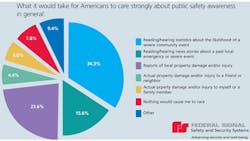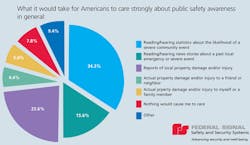National Emergency Preparedness Month: Overcoming Communications Challenges
In light of September being National Emergency Month, now is a good time for emergency managers and public safety officials to evaluate their communication strategies and how best to motivate people to take action in time of an emergency.
Trends show that Americans have become complacent in their reaction to emergency preparedness (or to emergency warnings). Even severe weather conditions do not motivate Americans to take action. In fact, the Federal Signal 2012 Public Safety Survey found less than one half (47 percent) would take action based on a potential severe weather warning, and 33 percent would require actual property damage or injury in order to care strongly about public safety awareness.
Overcoming these hesitations and complacency can be a challenge for emergency officials. Knowing how best to communicate and build out a communications strategy to prepare others is key. It begins with understanding the audience and human factors that can act as communications hurdles. Everything from language or disability barriers, to accessibility to computers or phones, to preferences in communication need to be considered when sounding an alarm.
Federal Signal believes that the most effective strategies today for tomorrow's emergency communications and mass notification systems will reflect the views of planners and decision makers who can answer "yes" to these central questions:
Have you made every effort to understand the needs of your community inside and out?
This encompasses researching and assessing the full scope of social and cultural norms, including language differences, as well as evaluating such behavioral factors as age and physical handicaps.
Have you applied this knowledge to available technologies and leaned on others’ experiences?
This includes a thorough analysis of current and potential mediums of communication with a focus on issues that relate to reach, control and variability.
Emergency managers and public safety officials can benefit greatly from understanding who will receive their message. By being able to answer “yes” to the above questions, emergency managers and public safety officials can prepare people for the worst and engage them in the importance of safety.
About the Author
John Von Thaden
vice president/general manager
John Von Thaden is the vice president/general manager for Alerting & Notification Systems, a unit of Federal Signal Safety and Security Group. He joined Federal Signal in 1998 as product manager for outdoor warning systems and has held positions in marketing, sales and advanced solution development during his 13-year tenure with the company. In his current role, Von Thaden has worldwide responsibility for alerting and notification solutions for government, health care and industrial markets. He holds a Master of Business Administration from Olivet Nazarene University and a Bachelor of Arts in communications from Valparaiso University.


